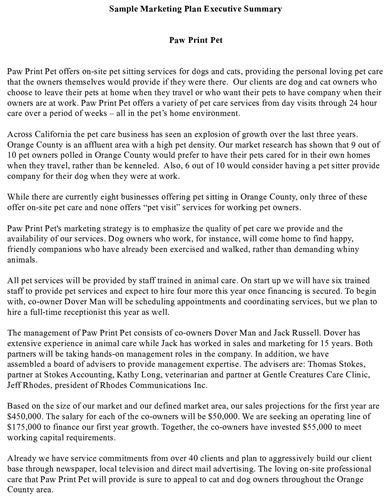Sample Executive Summary for a Marketing Plan: Includes Key Elements of What to Include
What is the Executive Summary?
When looking at your business plan, one of the first things that your readers will see is the marketing plan executive summary. This section of your business plan provides a great a way to give your readers a quick, short, and concise synopsis of your marketing plans and goals. Often times, this may be the most interesting section in the marketing plan because it serves as an overview of your income producing ideas and concepts.
What should be included in the summary?
Write the executive summary after you have completely written your marketing plan. It will contain an overview of the entire marketing plan, which allows you the ability to focus your ideas and concepts in a short summary. Nonetheless, there are several key elements that should be included. They are:
- Market Overview
- Competitive Overview
- Product Overview
- Goals and Objectives
- Strategies
- Action Plan and Implementation Schedule
- Evaluation Methods
Market Overview
Summarizing the market overview section consists of compiling the most important facts into a succinct document. Since you’ve already completed the leg work, sometimes it can be difficult to determine exactly what should be included in this section. For instance, how much information should the market overview include?
By answering the following five questions, your market overview section will have the right amount of information for your readers:
- How large is your market potential?
- What changes are occurring? Is the market increasing, decreasing, or flattened?
- How is the market segmented? Age, pricing, quality, income, or product usage?
- Identify your target market
- Identify your competitors
Competitive Overview
The Competitive Overview section includes a summary of your key competitors. This section also explains whether there is indirect competition that could essentially affect your business. For instance, if your company manufactures hair spray products, then your indirect competition could be manufacturers of hair brushes and combs.
As you are laying-out the details in this section, you should answer the following questions:
- What’s your product’s strengths and weaknesses?
- What are the major differences between your product and theirs?
- What is the pricing on their products?
- What other products are promoted?
- How are their products promoted?
- What are their goals?
- What are they doing to meet their goals?
Product Overview and Goals
Next, you need to describe some of the crucial details of your product. You should provide a brief summary of the following:
- The product’s purpose.
- The key features.
- The pricing structure.
- The marketing position.
- The distribution channels.
- Promotions and advertising tactics.
- Current packaging.
Goals and Objectives
Your goals and objectives are merely a description of what your business plans will be within a period of one to five years. Consequently, your marketing objectives should work to achieve all of your goals. So, before mapping out all of your objectives, first define your goals, and then allow your objectives to be the means to get you there. Ultimately, your goals should be solid and measurable, set on a timetable, attached to projected profits, and challenging.
Strategies and Action Plans
Strategies
Now that you have clearly laid the framework to your goals, the next step is to develop the best strategies to get you there. Usually, this is achieved by developing a marketing mix. The marketing mix represents the entire marketing process, which aids in getting you to your goals. It is composed of four key elements of the marketing process. They are product, price, place, and promotion. Developing strategies that are focused on these four areas, will assist in building a solid strategic plan.
Action Plan and Implementation Schedule
Your action plan and implementation schedule is also known as the Media Plan. This plan lays out details on how you decide to market your business products or services. You should include:
- Which media should you use? Magazines, internet, newspapers, etc.
- Offer explanations as to why you are choosing such media.
- List budgets for each type of media.
Sample Executive Summaries
Now that you have all of the information needed in order to provide a solid executive summary marketing plan, you can refer to the examples below. These were provided by the author for the reader’s reference. (Please click on image to enlarge.)


